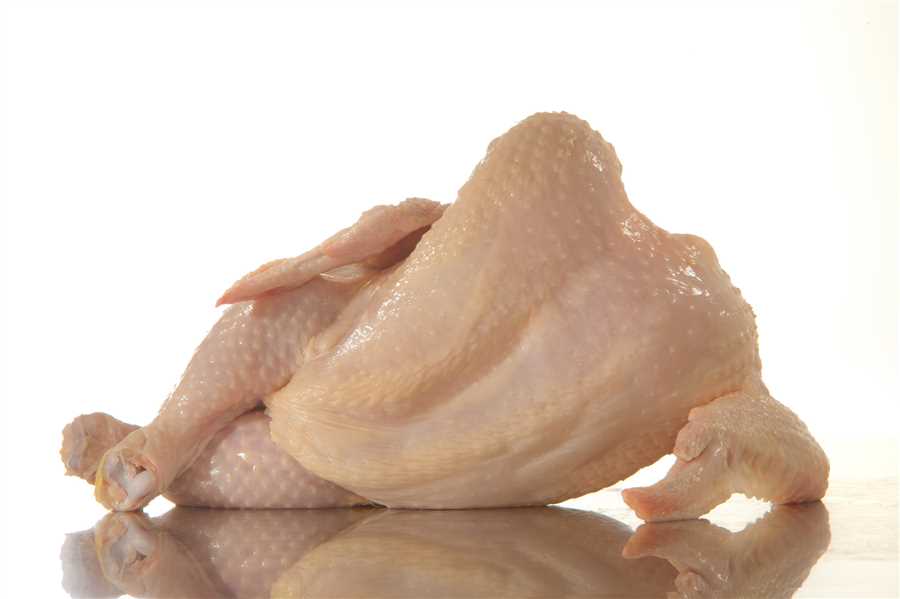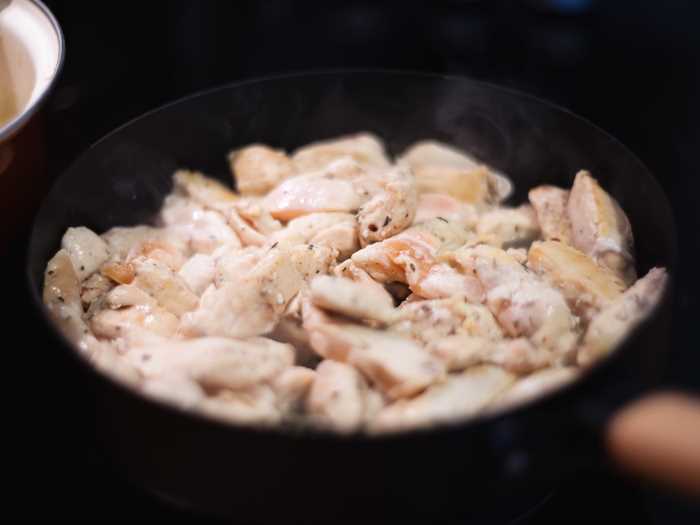



Salmonella is a type of bacteria that is commonly found in raw poultry, such as chicken. It can cause food poisoning and lead to symptoms like diarrhea, vomiting, and fever. Many people wonder if you can still get salmonella from cooked chicken, and the answer is yes. While cooking chicken properly can kill most types of bacteria, including salmonella, there is still a risk of contamination.
Cooking chicken to an internal temperature of 165°F (74°C) is generally considered safe and can help kill any bacteria present, including salmonella. However, it’s important to note that not all parts of the chicken may reach this temperature at the same time.
It’s also important to handle and store cooked chicken properly to reduce the risk of salmonella contamination. This includes washing hands after handling raw chicken, using separate cutting boards and utensils for raw and cooked chicken, and refrigerating cooked chicken within two hours of cooking.
In conclusion, while cooking chicken thoroughly can help kill salmonella bacteria, there is still a small risk of contamination. To minimize this risk, it’s important to follow proper food safety practices and handle cooked chicken carefully.
Understanding Salmonella
Salmonella is a type of bacteria that can cause food poisoning. It is commonly found in raw poultry, such as chicken, and can also be found in eggs and other unpasteurized dairy products. The bacteria can contaminate the meat during the slaughtering process or through cross-contamination in the kitchen.
Symptoms of Salmonella Infection:
A person infected with Salmonella may experience symptoms such as diarrhea, vomiting, fever, abdominal cramps, and sometimes bloody stools. These symptoms typically appear within 12 to 72 hours after consuming contaminated food.
Preventing Salmonella Infection:
To prevent Salmonella infection, it is important to follow proper food safety practices. This includes cooking poultry, such as chicken, to an internal temperature of at least 165°F (74°C) to kill the bacteria. It is also important to avoid cross-contamination by separating raw meat from other foods and using separate cutting boards and utensils.
Additionally, it is crucial to practice good hygiene, such as washing hands thoroughly before and after handling raw poultry, eggs, or any other potentially contaminated food. Properly washing fruits and vegetables is also important to remove any potential bacteria.
Overall, understanding Salmonella and practicing proper food safety measures is essential in preventing infection and keeping yourself and others safe from foodborne illnesses.
Does cooking chicken kill salmonella?
Salmonella is a type of bacteria that can cause food poisoning if consumed. It is commonly found in raw or undercooked poultry, such as chicken. However, when chicken is cooked properly, it can effectively kill salmonella bacteria and make it safe to consume.
Understanding salmonella
Salmonella is a group of bacteria that can cause salmonellosis, a type of food poisoning. This bacteria is often found in the intestines of animals and birds, including chickens. It can be transmitted to humans through the consumption of contaminated food, especially raw or undercooked poultry.
Cooking chicken to kill salmonella
Cooking chicken to the proper internal temperature is crucial in killing salmonella bacteria. The recommended safe minimum internal temperature for chicken is 165°F (74°C). At this temperature, the heat will kill the salmonella bacteria present in the chicken, making it safe to eat.
It is important to note that simply visually inspecting the chicken to confirm if it is cooked may not be enough to ensure the complete elimination of salmonella. Therefore, it is recommended to use a food thermometer to accurately measure the internal temperature of the chicken.
By cooking chicken to the recommended temperature, you can effectively kill salmonella bacteria and reduce the risk of food poisoning. It is important to handle raw chicken carefully to avoid cross-contamination and to always follow proper cooking guidelines to ensure food safety.
Preventing salmonella contamination

Salmonella contamination can be a serious health risk, but there are steps you can take to prevent it. By following proper food handling and cooking techniques, you can significantly reduce the risk of salmonella infection.
1. Practice good hygiene
Good hygiene is the first line of defense against salmonella contamination. Make sure to wash your hands thoroughly with hot, soapy water before and after handling raw chicken or any other raw food. Additionally, it is important to regularly clean and sanitize all surfaces and utensils that come into contact with raw chicken.
2. Cook chicken thoroughly
Cooking chicken to the correct internal temperature is crucial in killing any salmonella bacteria that may be present. The FDA recommends cooking chicken to an internal temperature of 165°F (74°C) to ensure its safety. Use a meat thermometer to accurately measure the internal temperature of the chicken.
Note: While cooked chicken is generally safe to eat and can eliminate salmonella, it is still important to handle it properly to prevent cross-contamination from other raw foods.
3. Avoid cross-contamination

Preventing cross-contamination is essential to avoid the spread of salmonella to other foods. Keep raw chicken separate from other foods, both in the refrigerator and during preparation. Use different cutting boards and utensils for raw chicken and other ingredients, and wash them thoroughly between uses.
Note: Never place cooked chicken on a plate or surface that previously held raw chicken without proper cleaning.
4. Store chicken properly
Proper storage of chicken is important to prevent salmonella contamination. Keep raw chicken refrigerated at temperatures below 40°F (4°C) and use it within two days of purchase. Additionally, make sure to store raw chicken away from other foods, especially those that are ready-to-eat.
Following these guidelines can help reduce the risk of salmonella contamination in cooked chicken and ensure the safety of your meals.
Recognizing the symptoms of salmonella infection
Salmonella is a type of bacteria that can cause food poisoning in humans. If you have consumed contaminated food, especially raw or undercooked chicken, you may experience symptoms of salmonella infection. It is important to recognize these symptoms in order to seek proper medical attention and prevent the spread of the infection.
Common symptoms
The symptoms of salmonella infection usually develop within 12 to 72 hours after consumption of contaminated food. Common symptoms include:
- Diarrhea
- Abdominal cramps
- Fever
- Nausea
- Vomiting
Additional symptoms
In some cases, individuals may experience additional symptoms, such as:
- Headache
- Muscle pain
- Blood in the stool
- Dehydration
- Loss of appetite
If you are experiencing any of these symptoms after consuming chicken or other potentially contaminated food, it is advisable to seek medical attention. Tests can be conducted to confirm salmonella infection, and proper treatment can be prescribed to help alleviate the symptoms and avoid complications.
Questions and answers
Can you get salmonella from cooked chicken?
Salmonella can still be present in cooked chicken if it was not cooked thoroughly. It is important to ensure that chicken is cooked to an internal temperature of 165 degrees Fahrenheit to kill any potential bacteria.
What is salmonella?
Salmonella is a type of bacteria that can cause food poisoning. It is commonly found in raw or undercooked poultry, eggs, and other contaminated foods. Symptoms of salmonella infection include diarrhea, fever, and abdominal cramps.
Are all chickens contaminated with salmonella?
Not all chickens are contaminated with salmonella, but a significant number of them can carry the bacteria. It is important to handle and cook chicken properly to reduce the risk of salmonella contamination.
What is the best way to prevent salmonella infection from cooked chicken?
The best way to prevent salmonella infection from cooked chicken is to ensure that it is cooked to an internal temperature of 165 degrees Fahrenheit. It is also important to practice good food safety measures, such as washing hands and surfaces thoroughly after handling raw chicken.
Can salmonella be killed by freezing chicken?
No, freezing chicken does not kill salmonella bacteria. While freezing can slow down the growth of bacteria, it does not eliminate them. It is important to cook chicken properly to kill any bacteria that may be present.
Can you get salmonella from cooked chicken?
Yes, you can still get salmonella from cooked chicken if it is not cooked properly. It is important to ensure that chicken is cooked to an internal temperature of 165°F (75°C) to kill any bacteria, including salmonella.
What are the symptoms of salmonella poisoning?
The symptoms of salmonella poisoning include diarrhea, abdominal cramps, fever, and vomiting. These symptoms usually appear within 12 to 72 hours after infection and can last for 4 to 7 days. In severe cases, salmonella infection can lead to dehydration and require medical attention.







